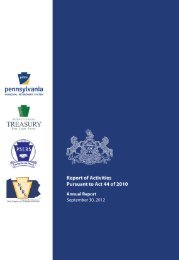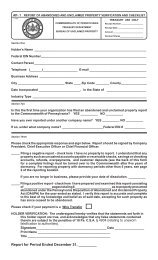Georgia Gaming Market Assessment - Pennsylvania Treasury
Georgia Gaming Market Assessment - Pennsylvania Treasury
Georgia Gaming Market Assessment - Pennsylvania Treasury
You also want an ePaper? Increase the reach of your titles
YUMPU automatically turns print PDFs into web optimized ePapers that Google loves.
West Virginia<br />
There is one casino and four racinos in West Virginia, but only two facilities are located in the<br />
northern panhandle which represent the main competition to southwestern <strong>Pennsylvania</strong><br />
facilities. A third facility, located near the West Virginia capital of Charles Town, would attract<br />
gamers as well.<br />
West Virginia racinos experienced rapidly increasing revenues from inception through 2006, due<br />
largely to continued changes in legislation to remove gaming position and game type limitations,<br />
as well as to increase betting limits. Additionally, it took nearly a decade for the market to reach<br />
a level of maturity with respect to having gaming participation rates being more typical of<br />
national averages. Legislation to permit slots in <strong>Pennsylvania</strong> resulted in the first notable yearover-year<br />
revenue decline in 2007, though this is being partially offset by the recent legislation<br />
that has permitted table gaming at the West Virginia racinos.<br />
With four racetrack casinos hosting a total of more than 11,250 lottery terminals, West Virginia<br />
gaming revenues approached the $1 billion mark in 2006. Revenue began to fall in 2007 and has<br />
continued through 2010, when the state’s slot revenue only totaled $723 million. The number of<br />
machines has decreased since 2008 to a total of just over 10,300 in 2010. Through the first four<br />
months of 2011, slot revenue is down 1% from 2010, while the number of slots is down almost<br />
10%. The table shows the West Virginia statewide slot revenue performance since 2003.<br />
West Virginia Statewide Slot Performance<br />
Gross Terminal Revenue Change Units Change Win/Unit % Change<br />
2003 $781,544,242 18.75% 9,583 27.75% $224.05 -7.05%<br />
2004 $874,193,223 11.85% 10,590 10.51% $226.77 1.21%<br />
2005 $931,670,726 6.57% 11,209 5.84% $224.04 -1.20%<br />
2006 $970,840,194 4.20% 11,349 1.25% $235.01 4.89%<br />
2007 $929,252,788 -4.28% 11,846 4.38% $215.50 -8.30%<br />
2008 $882,891,300 -4.99% 11,749 -0.82% $202.55 -6.01%<br />
2009 $805,246,659 -8.79% 11,253 -4.22% $196.58 -2.95%<br />
2010 $723,038,912 -10.21% 10,308 -8.40% $194.85 -0.88%<br />
Jan-Apr 2011 $236,863,692 -1.06% 9,702 -9.72% $204.09 9.98%<br />
Source: West Virginia Lottery<br />
Table games were introduced in late December 2007 at Mountaineer and Wheeling. Tri-state<br />
added tables in October 2008 and Charles Town added them in July 2010. Table revenue has<br />
grown from $77.6 million in 2008 to more than $133 million in 2010. This figure is expected to<br />
grow in 2011 as all four facilities operate table games for a full year for the first time. West<br />
Virginia tables have collected more than $68 million in revenue in the first four months of 2011,<br />
representing an increase of 128% from 2010. This increase is inflated, however, as Charles<br />
Town didn’t add tables till July 2010, and Charles Town represents more than $45 million of the<br />
state’s total, attributable to its 112 tables. Table revenue since 2007 is shown below.<br />
The Innovation Group Project #054-11 August 2011 Page 64





